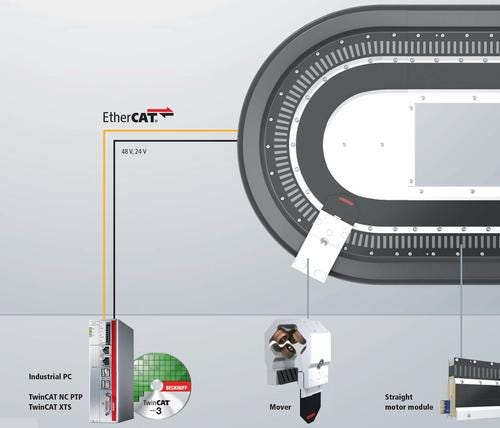Linear Transport System Offers Mechatronic Flexibility
July 9, 2013

A recent trend in automation machinery has been increasing use of standard robotic arms and mechanisms to create innovative system designs. The advantage of using standard robotic building blocks is the ability to use highly engineered, tested mechanical subsystems versus developing a customized solution for a specific need.
Now, a new linear transport system from Beckhoff Automation is combining linear motion sections with built-in motion networking, control software, and the ability to use PC-based control. The transport system can be configured with an arbitrary and highly flexible path configuration, in almost any length, wireless, and controlled by a single PC via magnetic fields. From a technology point of view, it is an evolution of previous drive systems but it combines mechanical flexibility and electronics into an interesting "building block" for advanced control of machines.
Click on the image below to view a photo gallery.

At the recent MD&M show in Philadelphia, Shane Novacek, marketing communications manager for Beckhoff, told us that the eXtended transport system (XTS) is a unique concept for combining an arbitrary number of curved or straight linear sections with any number of "movers," which can act individually or in groups. The result is a mechatronic system that offers a modular, fully integrated linear motor with power electronics and the ability to do displacement measurements all in one device.
The motor module contains the electromagnetic coils and other active functions necessary for the operation of the system. Only a power supply and an EtherCAT network connection are required. The module doesn't contain any moving parts and is not subject to wear.
The mover contains magnetic plates, which work together with the coils in the motor modules to generate motion. It absorbs the attractive forces of the magnets on both sides, and compensates for them as much as possible, which allows the rollers of the mover to run at high speed in the guide rail with low wear. There are no sliding contacts or cables to the moving part, which makes it a purely passive device.
The control and communication challenge of the XTS technology is that the drive control loops cannot be closed locally in the distributed drive modules, since the movers are moved with the aid of sequential solenoid coils. The drive amplifiers in the modules control several solenoid coils and have to deal with a continuously changing number of movers. Since the dynamic properties of the movers are to be carried beyond the module boundary, the control has to take place centrally.
EtherCAT motion networking is used to deal with these complexities using its real-time processing capabilities. Each network device picks the data intended for it from the common data frames or writes its data into these frames without first receiving, processing, and dispatching the frames again, as is usually the case. Frames are processed in the EtherCAT slave controllers during the transfer, with almost no delay.
According to Martin Rostan, head of technology marketing for Beckhoff, the net usable data rate of EtherCAT reaches more than 95 percent of the bit rate, since the Ethernet frame overhead does not occur per device and direction, but only once per approximately 1,500 bytes of process data, which can be distributed to any number of devices. High-precision clocks in the slave controllers are synchronized precisely and generate a common system clock, whose accuracy is independent of the frame sending jitter of the master. This enables EtherCAT to achieve synchronization accuracy on the distributed devices in the two-digit nanosecond range, and also means that no special hardware is required in the master.
As XTS technology continues to evolve, the goal is to offer additional types of sections and options that will further enhance the product offering.
Related posts:
About the Author(s)
You May Also Like



